When most of us begin to read, we are often drawn to books featuring familiar characters, settings, and experiences. Being able to see those experiences mirrored in our reading material can be validating and can keep readers returning to shelves in search of similar books. But as we grow older and more experienced as readers, we look for books that help us see the world differently. This week’s featured books highlight titles that help readers look at life through different lenses. Some of these just might change our lives and—at the very least—they may alter our worldviews.
Ages 4–8
Green Lizards vs. Red Rectangles. Steve Antony. 2015. Scholastic.
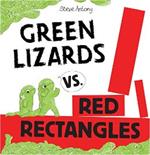 Sorting out what is at the root of most conflicts can be hard. Often, it’s something quite small such as being a different size, color, or shape. In this picture book, the only thing that’s clear from the start is the green lizards and the red rectangles are at war. As the conflict escalates, only one lizard even questions why they are fighting, and he ends up being beaten down for it. After exhausting all their resources, the two sides broker a peaceful coexistence in a creative way. Seems those lizards and rectangles had more in common than they originally thought. Originally published in the United Kingdom, the book makes excellent use of contrasting colors, shapes, and sizes to deliver its message.
Sorting out what is at the root of most conflicts can be hard. Often, it’s something quite small such as being a different size, color, or shape. In this picture book, the only thing that’s clear from the start is the green lizards and the red rectangles are at war. As the conflict escalates, only one lizard even questions why they are fighting, and he ends up being beaten down for it. After exhausting all their resources, the two sides broker a peaceful coexistence in a creative way. Seems those lizards and rectangles had more in common than they originally thought. Originally published in the United Kingdom, the book makes excellent use of contrasting colors, shapes, and sizes to deliver its message.
Lenny & Lucy. Philip C. Stead. Ill. Erin E. Stead. 2015. Roaring Brook/Macmillan.
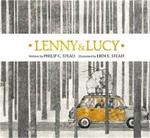 To his dismay and palpable unhappiness, Peter and his father move to a new place in the country. Nothing is as it was back home, and Peter draws comfort from his dog, Harold. But the house’s proximity to a bridge leading to some woods makes Peter anxious, and he fashions a Guardian of the Bridge with blankets and pillows. When he considers that this guardian, Lenny, might be lonely too, he creates a companion for him, Lucy. Then Millie, the girl next door, joins the group for play. The book’s cover is almost irresistible in its pathos as Peter watches all that is familiar being left behind. Created with carbon transfer printing, egg tempera, and charcoal, the illustrations are memorable, with a quietly meditative quality that prompts reflection. The story itself provides quiet reassurance that even in an unfamiliar place, there are new friends and routines to be found. Young readers may enjoy looking for the owl that appears on various pages and being reminded that having company helps dissipate most fears of the darkness and the unknown.
To his dismay and palpable unhappiness, Peter and his father move to a new place in the country. Nothing is as it was back home, and Peter draws comfort from his dog, Harold. But the house’s proximity to a bridge leading to some woods makes Peter anxious, and he fashions a Guardian of the Bridge with blankets and pillows. When he considers that this guardian, Lenny, might be lonely too, he creates a companion for him, Lucy. Then Millie, the girl next door, joins the group for play. The book’s cover is almost irresistible in its pathos as Peter watches all that is familiar being left behind. Created with carbon transfer printing, egg tempera, and charcoal, the illustrations are memorable, with a quietly meditative quality that prompts reflection. The story itself provides quiet reassurance that even in an unfamiliar place, there are new friends and routines to be found. Young readers may enjoy looking for the owl that appears on various pages and being reminded that having company helps dissipate most fears of the darkness and the unknown.
Ages 9–11
Claude in the Country. Alex T. Smith. 2016. Peachtree.
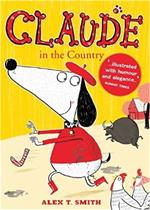 Claude, an adorable black-and-white dog who has more adventures than most humans, heads off for a trip to the country in this, his sixth outing. Along with his more reticent friend, Sir Bobblysock, the pair look for a day of relaxation and a change of scenery and find more than their share of trouble, as usual. After helping Mrs. Cowpat, a friendly farmer, by herding the sheep, gathering eggs, and cleaning the pigs, they head to the fair. The unflappable Claude even rescues a snooty judge from a raging bull. The story line and digital artwork are appealing to young readers for many reasons: the droll humor, the reference to cow patties, and curiosity as to what animals actually do while their humans are at work.
Claude, an adorable black-and-white dog who has more adventures than most humans, heads off for a trip to the country in this, his sixth outing. Along with his more reticent friend, Sir Bobblysock, the pair look for a day of relaxation and a change of scenery and find more than their share of trouble, as usual. After helping Mrs. Cowpat, a friendly farmer, by herding the sheep, gathering eggs, and cleaning the pigs, they head to the fair. The unflappable Claude even rescues a snooty judge from a raging bull. The story line and digital artwork are appealing to young readers for many reasons: the droll humor, the reference to cow patties, and curiosity as to what animals actually do while their humans are at work.
Happy Birthday, Alice Babette. Monica Kulling. Ill. Qin Leng. 2016. Groundwood/House of Anansi.
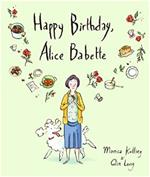 Birthdays are usually cause for celebration but, as this picture book shows, it is possible to enjoy the important day even when others seem to have forgotten it. In fact, celebrations can be fashioned from life’s most mundane moments or a walk through town. Based on the lives of writer Gertrude Stein and her companion, Alice B. Toklas, this picture book describes how Gertrude pretends not to have remembered Alice’s birthday while planning to surprise her with a feast complete with a cake. However, nothing goes as she plans. Although Gertrude gathers all the ingredients together with no problem, once she begins cooking and baking, she becomes distracted and forgets to keep an eye on the food. It is debatable whether getting down a certain thought or finishing a painting is more important than preparing a meal. Even though Gertrude’s plans to provide a splendid surprise for Alice don’t work out, Alice ends up having plenty of adventures—or, as she describes it, “a day of marvels”—as she meanders through the city. The illustrations, created with ink and then colored digitally, pay tribute to the delights of Paris where the story is set as well as a good friend’s best intentions, which surely should count for something.
Birthdays are usually cause for celebration but, as this picture book shows, it is possible to enjoy the important day even when others seem to have forgotten it. In fact, celebrations can be fashioned from life’s most mundane moments or a walk through town. Based on the lives of writer Gertrude Stein and her companion, Alice B. Toklas, this picture book describes how Gertrude pretends not to have remembered Alice’s birthday while planning to surprise her with a feast complete with a cake. However, nothing goes as she plans. Although Gertrude gathers all the ingredients together with no problem, once she begins cooking and baking, she becomes distracted and forgets to keep an eye on the food. It is debatable whether getting down a certain thought or finishing a painting is more important than preparing a meal. Even though Gertrude’s plans to provide a splendid surprise for Alice don’t work out, Alice ends up having plenty of adventures—or, as she describes it, “a day of marvels”—as she meanders through the city. The illustrations, created with ink and then colored digitally, pay tribute to the delights of Paris where the story is set as well as a good friend’s best intentions, which surely should count for something.
Ages 12–14
Anna and the Swallow Man. Gavriel Savit. 2016. Alfred A. Knopf/Random House.
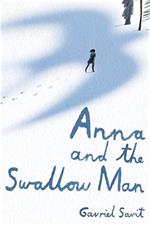 Holocaust stories abound, but this one offers something different. Set in Kraków, Poland, in 1939, the story follows young Anna Lania after she takes up with a man who has an affinity for birds. After her college professor father disappears during a purge of the city’s intellectuals, Anna has nowhere to go and she follows the mysterious man she knows only as the Swallow Man through the city streets and the woods. He teaches her survival skills and tells her stories. A master of disguises, he is clearly a brilliant man with some sort of tragedy in his past, but he never offers any explanations. When Anna befriends a Jewish man, the Swallow Man reluctantly allows him to join them. As they wander back and forth through various parts of the countryside, the Swallow Man keeps his own demons at bay until running out of medicine. Anna must figure out a way to save him for himself. Through it all, Anna learns important lessons about trust, difficult decisions, and the beauty that sometimes nestles within the harshest of moments. Readers will come to care for this young girl and hope with every fiber in their being that she finds something wonderful waiting for her at the end of her journey.
Holocaust stories abound, but this one offers something different. Set in Kraków, Poland, in 1939, the story follows young Anna Lania after she takes up with a man who has an affinity for birds. After her college professor father disappears during a purge of the city’s intellectuals, Anna has nowhere to go and she follows the mysterious man she knows only as the Swallow Man through the city streets and the woods. He teaches her survival skills and tells her stories. A master of disguises, he is clearly a brilliant man with some sort of tragedy in his past, but he never offers any explanations. When Anna befriends a Jewish man, the Swallow Man reluctantly allows him to join them. As they wander back and forth through various parts of the countryside, the Swallow Man keeps his own demons at bay until running out of medicine. Anna must figure out a way to save him for himself. Through it all, Anna learns important lessons about trust, difficult decisions, and the beauty that sometimes nestles within the harshest of moments. Readers will come to care for this young girl and hope with every fiber in their being that she finds something wonderful waiting for her at the end of her journey.
Claudia and Mean Janine (The Baby-Sitters Club #4). Raina Telgemeier. 2016. Graphix/Scholastic.
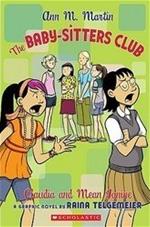 Based on the popular The Baby-Sitters Club series written by Ann M. Martin, this graphic novel version remains faithful to the original series’ intent and flavor, and readers will quickly relate to the characters as Claudia struggles with her feelings of inferiority because her parents seem to favor her older sister Janine who makes excellent grades while Claudia is lucky if she brings home Cs. The girls’ feuding continues even after their grandmother is hospitalized with a stroke. There is just enough focus on each of the members of the club and Claudia’s family and neighborhood to keep readers engaged, especially because there are shifting dynamics within the group as they head into their eighth grade year. Refreshingly, the book features self-empowered girls who aren’t caught up in the search for the right makeup or boyfriend. Readers will chortle at the depiction of many funny scenes concerning babysitting, including persuading a child that getting a little soiled is OK and the perils of washing a dog without a leash. Readers will never look at babysitting or family dynamics in quite the same way.
Based on the popular The Baby-Sitters Club series written by Ann M. Martin, this graphic novel version remains faithful to the original series’ intent and flavor, and readers will quickly relate to the characters as Claudia struggles with her feelings of inferiority because her parents seem to favor her older sister Janine who makes excellent grades while Claudia is lucky if she brings home Cs. The girls’ feuding continues even after their grandmother is hospitalized with a stroke. There is just enough focus on each of the members of the club and Claudia’s family and neighborhood to keep readers engaged, especially because there are shifting dynamics within the group as they head into their eighth grade year. Refreshingly, the book features self-empowered girls who aren’t caught up in the search for the right makeup or boyfriend. Readers will chortle at the depiction of many funny scenes concerning babysitting, including persuading a child that getting a little soiled is OK and the perils of washing a dog without a leash. Readers will never look at babysitting or family dynamics in quite the same way.
Up From the Sea. Leza Lowitz. 2016. Crown.
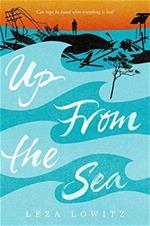 When a powerful earthquake and tsunami turn Kai’s life upside down on March 11, 2011, he must deal with the loss of his family and several classmates. The book’s opening pages describe the speed with which the sea rushes to shore, decimating the Tohoku region of Japan with almost 16,000 lives lost, as its force destroys almost all of the homes and trees in its path. The author relates Kai’s journey of recovery through a novel in verse, describing in vivid, heart-pounding language his desperate attempts to escape the water. Afterward, of course, there is almost nothing left, and Kai becomes depressed, embittered, angry, and unwilling to respond to the helping hands of others. When he has the chance to meet with disaster survivors from the Twin Towers terrorist attack in New York and hear their stories, however, Kai summons the strength and will to go on. Upon his return to Japan, he is beginning to heal, and finds a renewed purpose as he reaches out to others through his passion for soccer.
When a powerful earthquake and tsunami turn Kai’s life upside down on March 11, 2011, he must deal with the loss of his family and several classmates. The book’s opening pages describe the speed with which the sea rushes to shore, decimating the Tohoku region of Japan with almost 16,000 lives lost, as its force destroys almost all of the homes and trees in its path. The author relates Kai’s journey of recovery through a novel in verse, describing in vivid, heart-pounding language his desperate attempts to escape the water. Afterward, of course, there is almost nothing left, and Kai becomes depressed, embittered, angry, and unwilling to respond to the helping hands of others. When he has the chance to meet with disaster survivors from the Twin Towers terrorist attack in New York and hear their stories, however, Kai summons the strength and will to go on. Upon his return to Japan, he is beginning to heal, and finds a renewed purpose as he reaches out to others through his passion for soccer.
Ages 15+
Arrows. Melissa Gorzelanczyk. 2016. Delacorte/Random House.
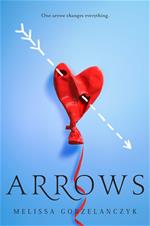 Most readers can relate to the plight of Karma Clark, caught up in a relationship with a guy who everyone knows is wrong for her. No matter how bad things get—and they get very bad—she just can’t fight her feelings for Danny. As it turns out, her unreasonable passion for this cad can be blamed on an arrow which started that crazy thing called love from Aaryn (Cupid’s son). Another of Aaryn’s arrows, the one intended for Danny, was a dud, and Danny is unable to reciprocate Karma’s boundless passion. Karma, a talented ballerina, becomes pregnant, has a daughter named Nell, and postpones her college plans while Danny messes around in every sense of the phrase. The remorseful Aaryn tries to straighten out the mess he left behind in Wisconsin, but he falls for Karma while seeing how Danny mistreats her. This book is the perfect antidote for those contemplating changing themselves for someone else or those tempted to wrap up all their emotions, dreams, and plans for the future in another. Although the book offers several humorous moments, it also firmly reminds readers to avoid anyone who refuses to support them or tries to hold them back. Sure to prompt conversations about relationships and choices, this book offers a unique perspective on how much say we actually have when it comes to falling in—and out of—love.
Most readers can relate to the plight of Karma Clark, caught up in a relationship with a guy who everyone knows is wrong for her. No matter how bad things get—and they get very bad—she just can’t fight her feelings for Danny. As it turns out, her unreasonable passion for this cad can be blamed on an arrow which started that crazy thing called love from Aaryn (Cupid’s son). Another of Aaryn’s arrows, the one intended for Danny, was a dud, and Danny is unable to reciprocate Karma’s boundless passion. Karma, a talented ballerina, becomes pregnant, has a daughter named Nell, and postpones her college plans while Danny messes around in every sense of the phrase. The remorseful Aaryn tries to straighten out the mess he left behind in Wisconsin, but he falls for Karma while seeing how Danny mistreats her. This book is the perfect antidote for those contemplating changing themselves for someone else or those tempted to wrap up all their emotions, dreams, and plans for the future in another. Although the book offers several humorous moments, it also firmly reminds readers to avoid anyone who refuses to support them or tries to hold them back. Sure to prompt conversations about relationships and choices, this book offers a unique perspective on how much say we actually have when it comes to falling in—and out of—love.
Up to This Pointe. Jennifer Longo. 2016. Random House.
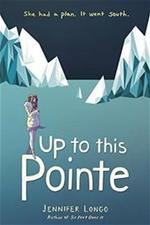 For most of her 17 years, Harper Scott has dreamed of a career in a ballet company. She has given up a great deal, including food, free time, and relationships, but is certain her sacrifices will be worth it. However, when the plans that she and her best friend, Kate, have don’t pan out, she impulsively heads as far away from her San Francisco home as she possibly can. Finagling her way onto a six-month-long research expedition in the Antarctic and trading on her ancestor’s name—yes, she’s related to the Robert Falcon Scott who explored the region a century ago—Harper has plenty of time to contemplate her choices and figure out a future that might still have room for dance. As an assistant to Charlotte, who is studying the effects of humans on the Adelie penguins, Harper realizes that running away from her problems hasn’t really made them go away. Eventually she must return to face the music and find a way to keep doing the thing she loves but on different terms than she originally planned.
For most of her 17 years, Harper Scott has dreamed of a career in a ballet company. She has given up a great deal, including food, free time, and relationships, but is certain her sacrifices will be worth it. However, when the plans that she and her best friend, Kate, have don’t pan out, she impulsively heads as far away from her San Francisco home as she possibly can. Finagling her way onto a six-month-long research expedition in the Antarctic and trading on her ancestor’s name—yes, she’s related to the Robert Falcon Scott who explored the region a century ago—Harper has plenty of time to contemplate her choices and figure out a future that might still have room for dance. As an assistant to Charlotte, who is studying the effects of humans on the Adelie penguins, Harper realizes that running away from her problems hasn’t really made them go away. Eventually she must return to face the music and find a way to keep doing the thing she loves but on different terms than she originally planned.
Barbara A. Ward teaches graduate and undergraduate courses in literacy at Washington State University, Pullman. She spent 25 years teaching in the public schools of New Orleans, where she worked with students at every grade level, from kindergarten through high school as well as several ability levels. She is certified in elementary education, English education, and gifted education. She holds a bachelor's in Communications, a master's in English Education from the University of Tennessee and a PhD in Curriculum and Instruction from the University of New Orleans.
These reviews are submitted by members of the International Reading Association's Children's Literature and Reading Special Interest Group (CL/R SIG) and are published weekly on Literacy Daily.